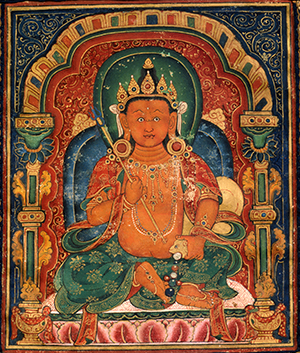
The Rubin Museum of Art presents a weekly meditation session led by a prominent meditation teacher from the New York area, with each session focusing on a specific work of art. This podcast is recorded in front of a live audience, and includes an opening talk, a 20-minute sitting session, and a closing discussion. The guided meditation begins at 15:40.
If you would like to attend Mindfulness Meditation sessions in person or learn more, please visit our website at RubinMuseum.org/meditation.
This program is supported in part by the Hemera Foundation with thanks to our presenting partners Sharon Salzberg, the Interdependence Project and Parabola Magazine.


Related Artwork

Theme: Intentionality
It is an intentional act every time we shift our awareness to sit in meditation. In this week’s podcast episode, Sharon Salzberg discusses how the intention to sit in meditation creates space for new possibilities and self-awareness, before leading a meditation session for listeners.
This Week’s Work of Art
This painting of a medicine buddha inspires our meditation. Along with the symbols of the lotus and the mandala, the medicine buddha guides practitioners on the path to enlightenment with the intention to move beyond suffering through meditation.
This painting is part of a set depicting each of the Fifty-One Deities of the Mandala of the Medicine Buddha, who is the focus of practices promoting health.
The orange deity Anila””Sanskrit for “Wind”””is one of the Twelve Yaksha Generals, protective guardians of the outer limits of the mandala. Decked in silks and jewelry, he holds a trident””a weapon and instrument of power””in his right hand and a mongoose spewing jewels that signify prosperity in his left. Framed by an elaborate mount, the scrolling lotus motif with flower blossoms is reminiscent of Chinese embroidery. The lotus sets its course to bloom above water while remaining deeply rooted in the mud below. It simultaneously represents the purity of the enlightened rising through the suffering of samsara, as well as non-attachment because its flowers blossom on long stalks unsullied by the mud below.
It is also embroidered with Eight Auspicious Symbols above (left to right, top to bottom: dharma wheel, white conch, victory banner, parasol, lotus, golden fish, treasure vase, and endless knot) and the Seven Treasures of the Universal Monarch below (minister, jewel, queen, wheel, elephant, general, and horse). These symbols of Tibetan Buddhism, evoked for healing purposes and general well-being, appropriately complement the mandala of the Medicine Buddha””the mandala being a meditation tool in the form of an architectural blueprint of a deity’s palace that enables human interaction with the divine.
About the Speaker

Sharon Salzberg, cofounder of the Insight Meditation Society in Barre, Massachusetts, has guided meditation retreats worldwide since 1974. Sharon’s latest books are Real Love: The Art of Mindful Connections and Real Happiness at Work: Meditations for Accomplishment, Achievement, and Peace. She is a weekly columnist for On Being, a regular contributor to The Huffington Post, and the author of several other books including the New York Times best-seller Real Happiness: The Power of Meditation, Faith: Trusting Your Own Deepest Experience, and Lovingkindness: The Revolutionary Art of Happiness. Sharon has been a regular participant in the Rubin’s many on-stage conversations.
